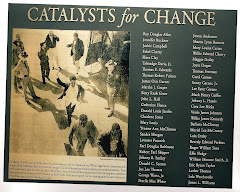
Sarah tried to give me a style but my hair did not cooperate fully.
I walked out of my room to get quarters for laundry and there was Ilana and Jared and Sarah asking me if I wanted to join them for dinner in Northampton at Spolleti’s. The next thing I new laundry was postponed and I was riding with the Yankee fan and marine biology major (with a tattoo of a dolphin)

Stacey who teaches physics and chemistry to seventh graders in Albany, NY
and cool hair Sarah and my pool(that's billiard) buddy, Andrew. Ben, a contractor who works with other sole proprietors in the area and is very happy to have work in this bad economy and also a connoisseur of hop concoctions and coffee, joined us with his wife Jessica who is in nano institute. Both are UMass grads. Ben got a philosophy major and chose the hands on rather than the surreal.
Dinner was good and we visited another place and home late again so laundry had to wait until morning. Suffice it to say I learned my life situation is not the only interesting one.
Yesterday was a no hands on day – everything was virtual including the tour of the Clean Room and the quite good instructional videos being developed by CHM (Center for Hierarchical Manufacturing) which we got to critique – some were quite good at this – especially Catherine from Ireland.
Now a Clean Room has never been my classroom and I was interested to learn about a Clean Room in science. Andrew used to work in one and had to roll the ceiling, walls and floors with an adhesive roller to collect all the particles and wash with an acid solution one week and a basic solution another. His brother has 100 rated Clean Room that is portable. The number represents how many particles in a cubic meter of air. I guess my room is a 10 million Room. The one at UMass is rated 1000 and the ones used for chip production in industry by robots where we humans that constantly fluff off dead skin and thousands of particles are not allowed is rated 0.
The cool idea for the week is Self-Assembly. Now this does not have to do with do-it-yourselfers. It has to do with an organism (in nature) or two polymers (in the lab) developing a structure without ongoing manipulation – it just happens after the genes trigger or the fluids are mixed. The wonders of nature continue to dazzle me on micro and macro scale. The cool structures in the lab are interesting also but no comparison. When hearing all this in a variety of ways, I had a brainstorm – during Toyota Tapestry MIC Project where we will collect and rear out all kinds of caterpillars, we can look at self-assembly in caterpillars and all the immense variety of caterpillars, cocoons, and butterflies to include the blue morpho that Mark cited in my animated discussion with him and I remembered getting one from a student when we discussed diffraction in physics. He is going to send me journal articles and lead researchers names in the field – a great connection with biology and physics two of my loves in science.
And as we got a tour of the nano facility and saw how resists were put on chips by spinning at 4500 rpm

Graduate student shows surface after spinning.
and how a PPMS Dewar

The grey one cylinder on the left.
like a big carafe with a vacuum layer a smaller carafe inserted with a liquid nitrogen layer and another carafe inserted with a Helium bath layer and then the internal carafe (housing the tested sample) could lower temperatures to 4 K (that is -269 C or in the -400s F) and then not only temperature could be manipulated but current as well. But the coolest part was a fill-in since the other part of the lab was under construction. Stefan from Germany and PhD student did the classic liquid nitrogen demo with the balloon where it shrunk as the temperature was lowered and then expanded back to shape without bursting when removed from the liquid nitrogen. However, I had never seen the process in reverse. He poured liquid nitrogen in a water bottle, capped it tightly and placed it in a garbage can. As the temperature rises as the nitrogen goes from liquid to gas it needs more room and . . . you can guess the rest. It took quite some time but the shot was heard round the room (don’t try this at home).
Be patient or rewind toward the end.
The pretty girl award goes to Ilana.

She teaches something interesting at Framingham High School I am sure. Ask her friend boy, Jared in an earlier blog if you like.
And finally Jonathan dazzled with two nano impact technologies in his lab. One will coat the surface of ships with nanoparticles that are hydrophobic and "push" away the water. This particles can put "painted" on at the same cost and will save $5000 dollars per day/ per ship in fuel costs. This research is funded by the US Navy and another project is like the non-newtonian fluids such as corn starch and water where someone can walk across in a kitty pool filled with such. The rapid stretch caused by your weight and running through makes the fluid rigid. The same thing happens with a kevlar vest interspersed with nano layers - the rapid "stretch" of the material caused by the bullet causes it to firm up and say no to death or injury - and the vests are lighter as well.


















No comments:
Post a Comment